Main Ridge Estate: Great Value In Small Quantities From Australia’s Mornington Peninsula
by Ken Gargett
There are lots of good, decent people in the wine industry the world over, but they don’t come much more highly respected than Nat and Rosalie White.
Now, if that was it we’d all be on our way and I would not be sitting here typing away, at least not about Nat and Rosalie. Fortunately, they also happen not only to have established the first commercial winery on the Mornington Peninsula, but to have set standards that few have ever matched, let alone topped.
The Mornington Peninsula is a region south/southeast of Melbourne, Australia’s second largest city. Around an hour’s drive, it was a mix of beaches, hills, farms, horse estates (I have no idea what one calls a horse estate, but I think you know what I mean) and more, very much the hideout for Melbourne’s rich and private.
Back in the very early 1970s there was not a vine to be found, although the earliest plantings were back in 1886. Within five years, there were six vineyards producing fruit on the Peninsula. A few years later, a similar story as endured by numerous regions at the time: economic conditions, changing customer preferences, and the march of phylloxera sowed seeds of the beginning of the end. By the 1920s, the vineyards were abandoned.
In the 1950s, Seppelt planted 100 acres at Dromana, but they were destroyed by bush fires in 1967 (something today’s winemakers would well understand after the horrendous summer 2019/2020 experienced across much of the country).
Another attempt, one that has now blossomed beyond anything those pioneers could have envisaged, came in 1972.
The old “who did what first” arguments have benighted numerous regions (even when many of those involved are still with us), but here it seems that it was Baillieu Myer at Elgee Park who first put vines into the ground.
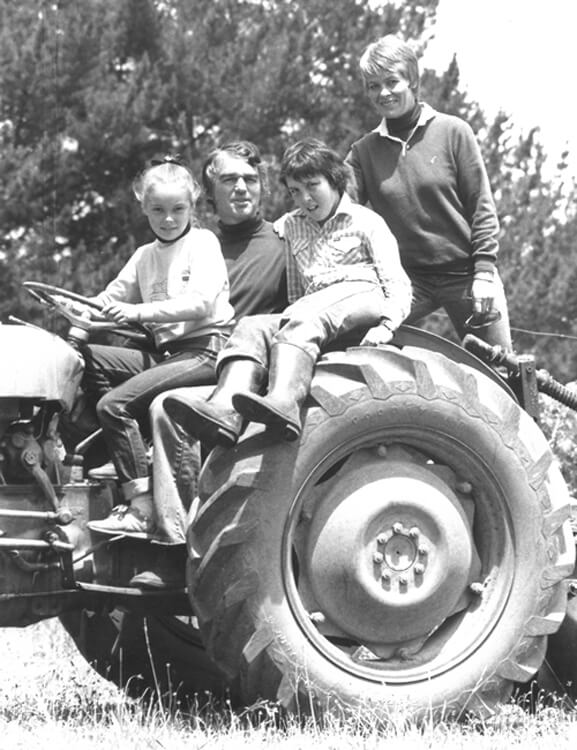
The White Family, Main Ridge Estate, Mornington Peninsula, Australia
The first registered commercial winery, Main Ridge Estate, was established by the Whites in 1978 – I believe that their first vines were planted in 1975 and 1976 – and the region’s first wines came from them for the 1980 vintage. Technically, their first vintage was 1979, a whopping 20 liters. Today, the production of Main Ridge Estate is estimated at around 1,200 cases annually, less on occasion.
Main Ridge Estate’s beginnings
The Whites had been inspired by a visit to Burgundy during an overseas trip in the 1960s. Both were gainfully employed – Nat as an engineer and Rosalie as a teacher – but they dove in and purchased a lemon orchard that was just under three hectares in the bush on the Peninsula.
One often reads how a region’s pioneer has spent years researching soils, aspects, history, climate and more before finally, after many unsuccessful starts and similar research in numerous other regions, narrowing down the search to the perfect block. That isn’t quite the story here.
The Whites picked the block because it had easy access back to Melbourne, something not usually ranking too highly on the list of a vineyard’s attributes. Although, as the site didn’t even have road access, I imagine that would have slowed the trip to Melbourne a smidge. If ever a place needed work, this was it.
Sometimes you get lucky. Nat and Rosalie had stumbled onto a site that is still the envy of much of the rest of the Peninsula. It is located in the Red Hill subregion. Such has been the contribution and influence of Nat that in 2017 he was awarded the Order of Australia for services to the wine industry.
Originally, Nat planted seven different varieties. While there has been some dabbling over the years, the range is basically the MRE Chardonnay, MRE The Acre Pinot Noir, and the MRE Half Acre Pinot Noir. Tiny amounts of Pinot Meunier and Merlot are still made. Total vineyard area sits at seven and a half acres, every vine planted by Nat.
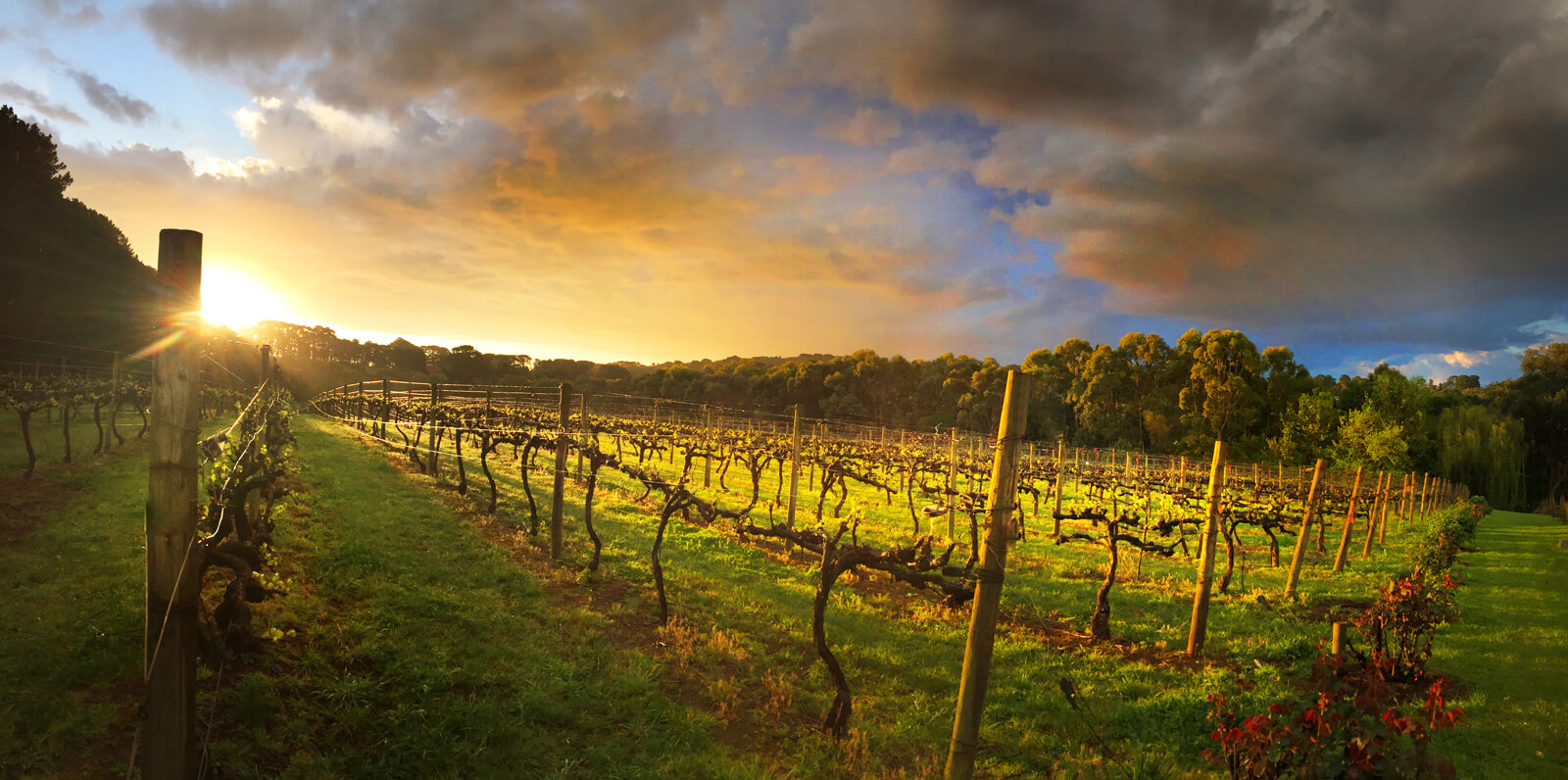
Main Ridge Estate, Mornington Peninsula, Australia
Despite those seven varieties, the Whites’ key plantings were always Chardonnay and Pinot Noir, both in their absolute infancy in Australia at the time. Remember that the first commercial Chardonnay made here was the 1971 Tyrrell’s Vat 47.
But Burgundy can do that to you. Fortune smiled again, as these have proved to be the perfect grapes for this cool climate region (well, climate change is doing its best to alter the world’s view of that). Across the Peninsula, there have been attempts to make Cabernet work, nothing really to write home about, and Paringa Estate makes sensational Shiraz. Varieties like Pinot Gris have also made a mark.
For many, and I am one, this region makes the best Pinot Noir in Australia. Forgive the generalization as there are, of course, a great many fine examples from many other regions, and the Pinots of the Peninsula also vary considerably as one moves through the subregions.
Chardonnay is a more difficult case to make, not because the region’s Chardonnay is not often superlative, but because there are many challengers also making stellar Chardies.
Success for these two varieties is partly attributable to the layout of the region, the maritime impact with water on three sides. No vineyard is more than seven kilometers from the coast.
There are now more than 200 vineyards, many wineries (50 to 60 cellar doors), and a thriving wine tourism industry with numerous sensational restaurants. Once the virus battle is over, the restaurant at Ten Minutes by Tractor is a must (it has had its fair share of troubles with a fire destroying much of the place a few years ago). The Jackalope at Willow Creek is another.
But remember, the Peninsula is all a bit like Gulliver in Lilliput. Everything is on a small scale. You will not find the major players in the Australian wine industry in residence here.
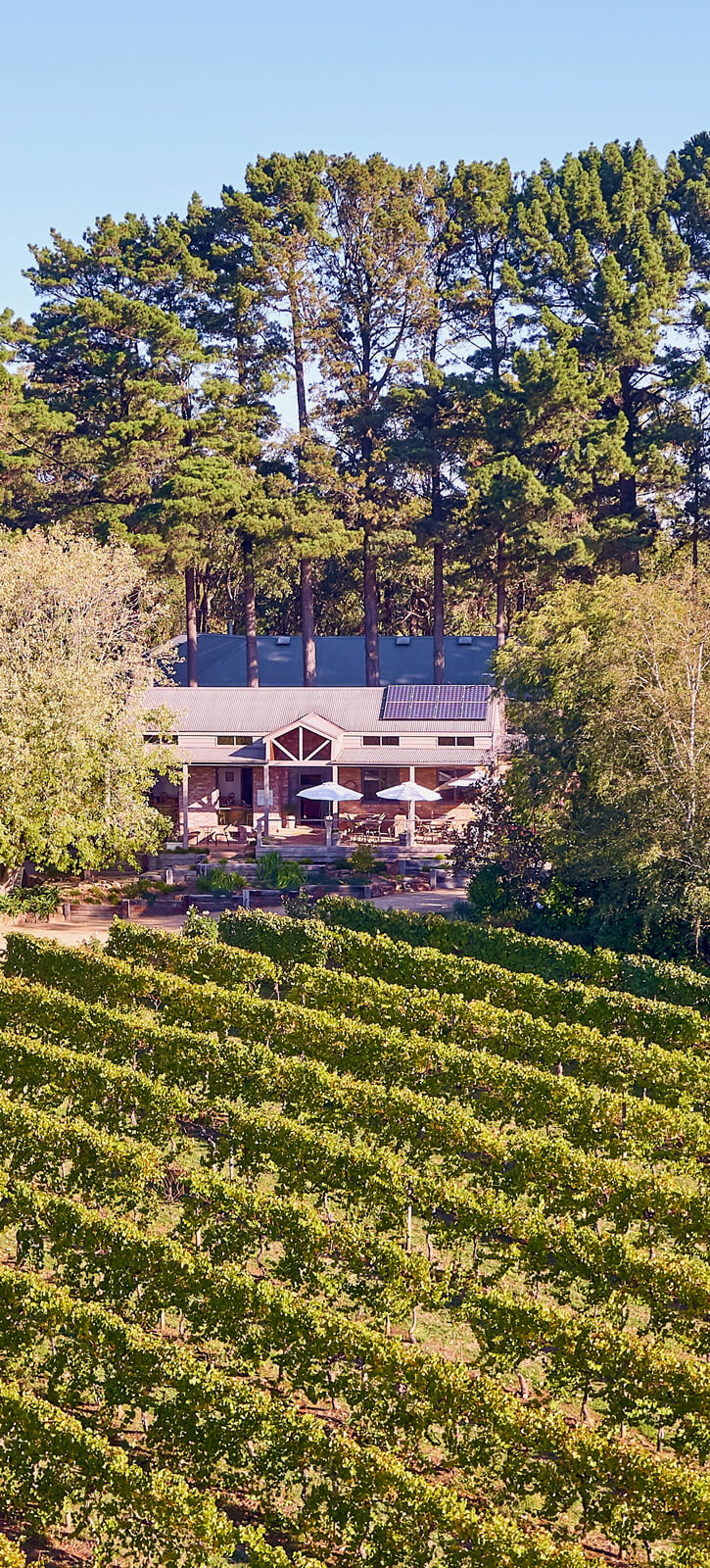
Main Ridge Estate, Mornington Peninsula, Australia
This, however, is not about the region as a whole. Tiny it might be, Main Ridge Estate has been considered as producing not only some of the Peninsula’s best Pinot and Chardonnay, but some of the best anywhere in Australia, pretty much from day one.
Small quantities of its wines do manage to make their way to international markets, but you’ll need to search for them. Contacting the winery for information might be your best bet. For locals, join their mailing list.
Main Ridge Estate’s wines
It’s worth noting that if you could not find any 2011 Pinots, stop looking. The entire Pinot crop was discarded by Nat as the vintage was simply not satisfactory. And as all wines are made from estate-grown grapes only, there was nothing they could do.
As mentioned, the first vintage was 1980 and the wines were released in 1981, a Pinot Meunier for AUD$5.50, a Pinot Noir for AUD$5.60, and finally a Cabernet for AUD$6.50. In those days, they were hefty prices.
If I recall correctly, I bought a Hill of Grace in 1982 for AUD$5.50, which gives you a comparison. The wines were soon winning gold medals at wine shows. In 1987, Nat completed his wine studies at the Charles Sturt University (which would seem to be a little out of the normal order, but seems to have worked).
Recognition for the wines has never stopped. Sadly, in 2015 Nat and Rosalie felt it was finally time for them to stop. With no family of their own interested in taking over, they sold Main Ridge Estate to the Sexton family.
Their devoted customers and fans across the nation were devastated (and I suspect also felt a little sympathy for the Sextons, as those were mighty shoes to fill) and full of dread as to what might happen. Nat and Rosalie have remained close and have assisted the new team, Nat acting as a mentor. The transition seems to have been seamless. The wines have not missed a beat.
Tim and Libby Sexton are the new owners, and their son, James, a sommelier, is the new winemaker (he is also studying winemaking at Charles Sturt, so following the Nat White order of things). The entire operation, including the home, is believed to have changed hands for around AUD$3.25 million, an amount that would have seemed ludicrous back when Nat and Rosalie were putting those first vines into their soil. They deserve every cent.
Looking back over notes taken from a number of visits and tastings (I have more though could not find everything – yes, you would think I’d be better organized but it is an ongoing process), the attention to detail and the exceptional quality drips from every page.
Spur pruning is used to control crop levels and to keep the berry size small, though there is cane pruning with the Chardonnay. The aim, as expressed by Nat, was for evenness across the bunches. Green bunches are especially to be avoided – something that appears in my notes from every visit.
There was never an aim for a set level of cropping – it is always vintage dependent. For Nat, it was “all about balance.” He also aimed for open canopies to avoid any botrytis infection. A modified form of Scott-Henry trellising is used.
Pinot barrels were split between Sirogue and St. Martin, while Chardonnay was matured in 100 percent Sirogue barrels.
Nat moved from a little use of stems to full destemming, and the wines are unfined and unfiltered. The Chardonnay spends almost a year on lees.
These are a collection of tasting notes taken at various times, some dating back a while so they need to be taken with that grain of salt in mind. At the end, the three most recent releases from the 2018 vintage.
Chardonnay 1992. Tried in 2014, this was wonderfully mature, nutty, and complex. Oatmeal and honey. Terrific then, but I am not sure it would still be travelling quite so well today. 94.
Chardonnay 2001. Hints of corn here. Oatmeal. This was tried in 2007 when it was still vibrantly alive. Some complexity was building, but this had time ahead. 91.
I tried it again in 2014 and the notes were surprisingly similar, though there was extra richness. For me, still 91.
Chardonnay 2005 The first thing to note here is that my scribblings indicate that the price was AUD$50. Given that the current price is only AUD$65, this makes today’s wines amazing value. Slight oatmeal and mineral notes. Good acidity, balance, and length. A lovely wine with good intensity. 93.
I tried this wine again a couple of times about five or six years later and it was exhibiting more complexity but still with fresh acidity. A slight chalkiness had emerged, but the creamy texture was still there. And it still looked as though it had years ahead of it. A lovely lingering finish. 94.
Chardonnay 2006. Grilled nuts, orange blossoms, spices, citrus, minerals. Dry honey. Tried in 2013 and still exhibiting everything necessary for a very long life. 93.
Chardonnay 2007. This has more intensity than the 2005, with more lifted and open flavors. Very fine integration of oak and that creamy texture was a highlight. The only query I had at the time was the length. 93.
Chardonnay 2009. This was youthful and refreshingly clean as a young wine. Minerals and stone fruit. Just needed time. Excellent. 94.
Chardonnay 2010. For me, this was one from the leaner end of the spectrum but none the worse for that. The elegance seems to be very much part of the Main Ridge Estate DNA. This has grapefruit and lemon notes. Pristine. Beautifully balanced and very, very long. 96
Pinot Noir Half Acre 2001. Some dry vegetation characters were emerging adding to the complexity. Red berries and elegance. Drinking beautifully. 91.
Tried again in 2007, spices, coffee beans, florals, and red cherry. Again the finesse and elegance with good intensity. Still travelling very well, indeed, looking even better. 92. (Looking back at these scores, I really was a bit of a Grinch in those days).
Pinot Noir Half Acre 2003. This had only been bottled for eight weeks when I saw it and yet it still was superb. Raspberry and mulberry notes. Supple and soft tannins. Terrific varietal expression of a classic Pinot. 93.
Pinot Noir Half Acre 2005. 2005 was a low yielding vintage. Lots of cherry flavors here, bright acidity. The wine was taut with finesse and elegance. A very promising future. 93.
Pinot Noir Half Acre 2007. Warmer year, and the wine was about six years old when I tried it. Very aromatic. Liqueur cherry, coffee bean. Silkiest of tannins. Supple. Wonderful wine. 96.
Pinot Noir Half Acre 2010. This had a more high-toned cherry note than The Acre. Spices and more truffles and earthy notes at the time. Lovely fragrances. Bright acidity. At the time, it screamed a wine with a very long life ahead. 95.
Pinot Noir 2010. Now referred to as The Acre, to distinguish it from the Half Acre. This walked the fine line between beautifully elegant and slightly austere. Very fine tannins. Balance, as always. An exciting future, surely. 94.
I looked at this again a couple of years later and was blown away. Rose petals, cinnamon, cherries. Soft tannins, great intensity, elegance, and everything suggesting a brilliant future. 96.
Main Ridge Estate releases from the 2018 vintage
Before looking at these, it is worth mentioning the concept of value. These are, as you can probably gather, wines that I think are of superb quality. The prices make them ridiculously good value, especially as they are made in such small quantities. This is largely Village Burgundy prices for wines that soar above that lowly status. If you can find anything from that illustrious region that compares for value, please let me know.
Main Ridge Estate Chardonnay 2018
From 43-year-old vines, clones being 70 percent 10V5 and 30 percent Mudgee Mix; 6 hours skin contact; 100 percent native yeasts; 100 percent Malo; 100 percent barrel fermentation; Sirogue barrels, a third each of first, second, and third use. 13.5%. AUD$65.
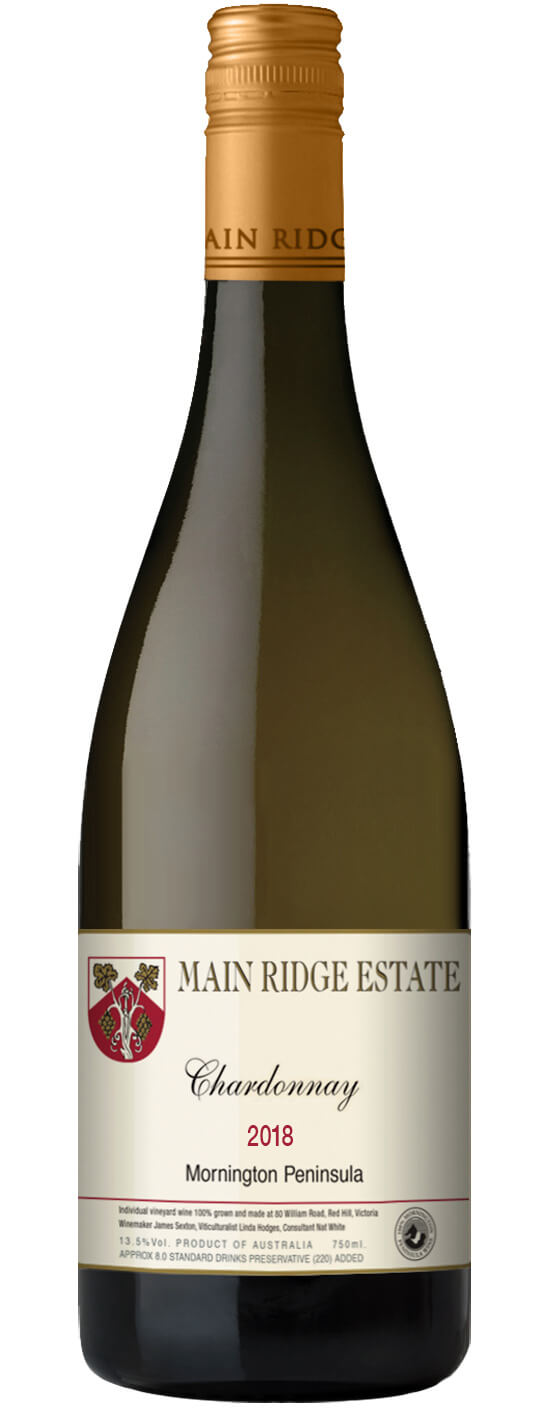
Main Ridge Estate Chardonnay 2018
An array of flavors: cashew nuts, oatmeal, stone fruit. There is excellent oak integration. Balance is the key. Good intensity. This vintage offers fuller flavors than some releases. Good intensity and the intensity never waivers. A wine of great length. Texture is a highlight. Superb, creamy texture. Good complexity. A stunning Australian Chardonnay and one with real potential for the future. 96.
Main Ridge Estate Pinot Noir The Acre 2018
All vines are 43 years (or were at the time this was made). Clones, as I know many pinotphiles take these things extremely seriously, are MV6, D2V5, D2V6, 114, and 115. 100 percent destemmed, 18 days on skins and 100 percent native yeasts.
French barriques, a mix of Sirogue and Saint Martin, first, second, and third use. Unfined and unfiltered. 14.1%, AUD$75. Destemmed but it does exhibit some sappiness. A vibrant style. Strawberries, dry herbs, slightly darker fruits than the Half Acre. Youthful and slightly firm on the finish. Concentrated and just a hint of austerity at this stage. Fine tannins. Good length. This has a long way to go. Good intensity. It will be better in three to five years. 93.
Main Ridge Estate Pinot Noir Half Acre 2018
Details are identical as for The Acre, with the exception that the clones are MV6, D2V5, D2V6, and 777. The alcohol level is 14.3 percent and the price AUD$90. For me, this is the pick of the Pinots. More florals here, red fruits, spices, red cherries.
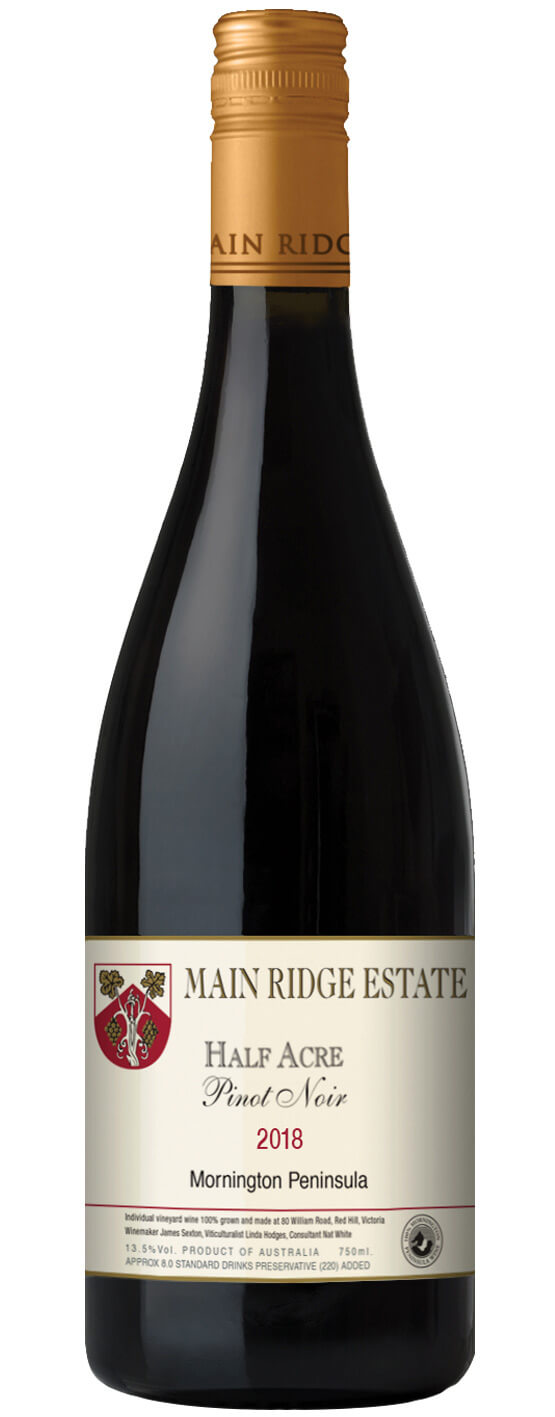
Main Ridge Estate Pinot Noir Half Acre 2018
Finely balanced and seamless. There are lovely aromatics. A Pinot that dances. Finesse and elegance. This is slinky and seductive. Very silky tannins. Impressive length. The wine lingers exquisitely. A Pinot with real promise. Love this wine. 96.
For more please visit mre.com.au.
You may also enjoy:
Yalumba The Caley 2014: An Aussie Classic From The Barossa Valley
Smith & Sheth Cru: Rich, Exciting Wines From New Zealand With Alluring Aromas
Sparkling Wine From Tasmania: Not Yet Champagne Level, But Very Close



Leave a Reply
Want to join the discussion?Feel free to contribute!